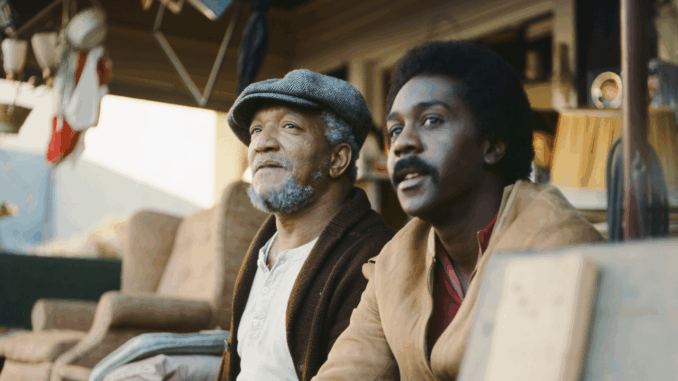
For a generation of television viewers, Sanford and Son was a cultural phenomenon. It was a show defined by the cantankerous, heart attack-prone antics of Fred G. Sanford (Redd Foxx), the long-suffering exasperation of his son, Lamont (Demond Wilson), and the hilarious, often-biting banter that made it one of the most beloved sitcoms of the 1970s. The show, a creation of the legendary Norman Lear, was known for its masterful blend of physical comedy and sharp, witty dialogue. But while it is often remembered for its sometimes problematic and outdated humor, there is one episode that stands out as a truly groundbreaking and surprisingly empathetic look at a gay storyline.
That episode is the two-part, hour-long special from the show’s final season, titled “The Hawaiian Connection.” This episode, which first aired in 1977, is not just a quirky detour for the characters; it is a major landmark in the history of LGBTQ+ representation on television. In a time when gay characters were either relegated to punchlines or were depicted as villains, this episode presented a gay man in a way that was both nuanced and ahead of its time, a testament to the show’s—and Norman Lear’s—willingness to use comedy as a vehicle for social commentary.
A Hawaii Vacation and an Unexpected Connection
The episode’s plot is a classic Sanford and Son farce with a unique twist. Fred and Lamont win a trip to Hawaii and are overjoyed at the prospect of a relaxing vacation. Upon arriving, they meet a friendly, well-dressed, and seemingly polished man named Mr. Wheeler, portrayed by actor Howard Platt. The two Sanfords, of course, are their usual suspicious selves, but they are charmed by Mr. Wheeler’s kind demeanor and his generosity. The plot is filled with the usual comedic hijinks: Fred gets a fever, Lamont gets entangled with a beautiful woman, and the two get caught up in a con.
The twist, however, comes when Fred and Lamont return from their vacation. Mr. Wheeler, who they had befriended in Hawaii, shows up at their junkyard in Watts. It is here that the episode takes an unexpected turn. Mr. Wheeler, in a moment of polite but direct conversation, reveals that he is gay. The reveal is handled with a remarkable degree of grace and maturity for its time. Mr. Wheeler is not a caricature; he is a fully-realized person who is simply living his life. The humor does not come from his sexuality but from Fred’s reaction to it, which is, of course, a mix of bewilderment, discomfort, and a dose of his trademark, misplaced fear.
Why It Was a Groundbreaking Moment
In the 1970s, the depiction of gay characters on television was abysmal. They were either the butt of a cruel joke, a source of moral panic, or were completely invisible. Before this episode, the closest a mainstream sitcom had come to addressing the topic was through caricature or ridicule. Sanford and Son, in stark contrast, took a significant step forward.
The episode’s brilliance lies in its refusal to make Mr. Wheeler a punchline. He is a sophisticated, polite, and intelligent man. His sexuality is a fact about him, not a source of humor. The comedy comes entirely from Fred’s a-political and almost ignorant reaction. Fred’s bewilderment and discomfort, while problematic by today’s standards, were a reflection of the attitudes of the time. The show’s purpose was to shine a light on these attitudes, not to condone them. It used Fred’s bigotry as a way to expose the absurdity of it. It’s a method that Lear used to great effect in all of his shows, from All in the Family to Maude. He used comedy to start a conversation, and he was never afraid to make his main characters look foolish for their prejudices.
By placing a gay character in a setting like the Sanford & Son junkyard, the show challenged the preconceived notions of its audience. The viewers, who had grown to love Fred and Lamont, were forced to confront a reality that was a part of American life. The fact that the episode was aired on prime time and reached a massive, mainstream audience, made it a truly significant moment in television history. It was a bold and brave move, a testament to the show’s commitment to telling stories that mattered.
The Enduring Legacy
While “The Hawaiian Connection” may not be perfect by today’s standards, it remains a landmark in the history of LGBTQ+ representation on television. It showed that a mainstream, working-class sitcom could tackle a sensitive topic with a degree of grace and maturity. It showed that gay characters could be fully-realized human beings, not just stereotypes. It set a precedent for future shows to handle gay characters with more nuance and less ridicule. It was a major step forward, and it is a testament to the show’s enduring legacy.
In the end, while Sanford and Son may be remembered for its broad humor and its masterful comedic performances, this episode stands out as a powerful reminder of the show’s bravery and its willingness to use comedy as a vehicle for social commentary. It is a tribute to the genius of Norman Lear, who believed that a sitcom could be more than just a source of laughter; it could be a force for change. This episode is a perfect example of that. It is a testament to the power of a television show to reflect the world we live in and to challenge us to be better.
